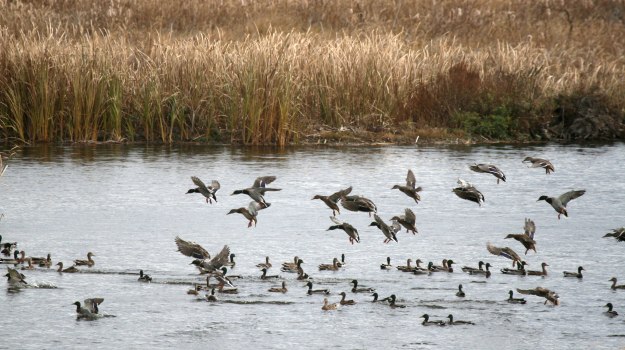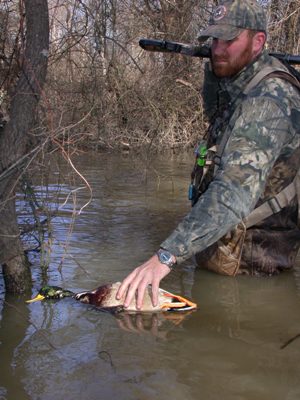
One of the reasons we spend more time duck hunting in Arkansas than we do duck hunting in Mississippi is that we’ve found fewer and fewer places in Mississippi where we can dodge hunting pressure. We've discovered that if we can walk into an area rather than going to it by boat, our opportunities are much greater for dodging hunter pressure than if we use a boat to reach the places we want to hunt. Most of the regions we hunt are off the beaten path and require more effort than putting in a boat and driving the boat to a duck hunting area. Sometimes, we’ll take our boats to what we've discovered is a great place to hunt ducks. But then, we’ll park our boats and go on foot about 1/4 or 1/2 mile more by wading to get into spots where most hunters can’t reach in a boat. Or, we walk in from the bank and wade out to a really good spot in standing timber that’s difficult to reach. But due to using GPS and aerial photos, there are fewer and fewer productive spots on public lands that everyone doesn’t know.
About 15 years ago, when we first started hunting public lands, we’d come back to the boat ramp, and we’d always be asked, “Where are y’all finding all these ducks?” Sometimes we’d arrive back at the ramp with six or eight limits of ducks, and the other hunters at the ramp might not have taken any or only one or two ducks. But now, when people hear six or eight of us shooting, they take their cell phones or SmartPhones out of their pockets, tap the compass app, and learn the direction from where the shooting is coming. Then they look at their aerial photos and say to each other, “I see right here where those guys are hunting.”
 Learning ways to get to places either before other hunters get there, or using routes from land to spots where most other waterfowl hunters won’t go has been another one of the main reasons for our success. We’ve also learned that week days are much more productive than hunting on weekends. Our favorite days to hunt are Tuesday, Wednesday and Thursday. Monday can be a good day, because you're not going to have a lot of hunting pressure on Monday. However, the ducks have probably been shot at an awful lot on Saturday and Sunday, and they’ll be much more spooked on Monday than they will be on Tuesday, Wednesday and Thursday.
Learning ways to get to places either before other hunters get there, or using routes from land to spots where most other waterfowl hunters won’t go has been another one of the main reasons for our success. We’ve also learned that week days are much more productive than hunting on weekends. Our favorite days to hunt are Tuesday, Wednesday and Thursday. Monday can be a good day, because you're not going to have a lot of hunting pressure on Monday. However, the ducks have probably been shot at an awful lot on Saturday and Sunday, and they’ll be much more spooked on Monday than they will be on Tuesday, Wednesday and Thursday.
Another secret for waterfowling success is to hunt public lands when all the other hunters have left. Many of the state and federal waterfowling areas require hunters to be off the water by noon, and they may have a regulation that says you can’t get on the water or into one of these public-hunting areas before 4 a.m.. We usually arrive at 4 a.m. to have the time before daylight to get to where we want to go. Most of the time, we can get our limit of ducks before 9 a.m. However, sometimes our best shooting takes place between 9 a.m. and noon. A lot of people get discouraged at first light, if they're not seeing or taking a lot of ducks. So, they usually leave by 9 a.m. Ducks wise-up quickly to hunter behavior and hunter movement, especially later in the year. We've found that later in the season many of our best hunts take place between 9 a.m. and noon.
In Mississippi, we mainly take mallards and gadwalls. When we hunt in Arkansas, we pretty much exclusively take mallards. We have taken some teal and wood ducks. However, we mainly hunt mallards.
The first day of the 2016 duck season I hunted in Arkansas was during the drought across much of the South. We had a difficult time finding ducks in those drought-stricken areas. Some of the spots I traditionally had hunted were bone dry. My friends and I had done some serious scouting the week before opening day, but the region we had planned to hunt on opening day didn’t have any water in it, even though it had plenty of water the week before. So, we went into a place we never had hunted before just to try it. On the first day when we had zero water, we took zero ducks. The following day on Sunday when we went to this new place we never had hunted previously, we had 15 people hunting, and we took 40 mallards. The place we hunted on opening day looked a lot better than the new place we hunted on Sunday. But for some reason, the ducks just weren’t using the spot we hunted on Saturday, but they were using the spot we hunted on Sunday.
Day 1: How to Find the Ducks Before You Hunt Them
Tomorrow: How to Know Places to Avoid and Where to Hunt on Public Lands



























